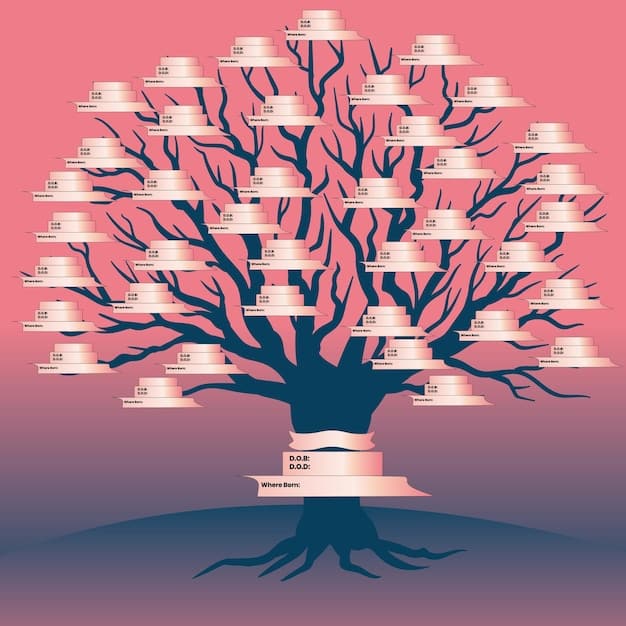Economic Forecast: Preparing Your Business for the 2025 Recession

The economic forecast suggests a potential recession in 2025, requiring businesses to proactively prepare by assessing financial health, diversifying revenue streams, and implementing cost-saving measures to mitigate risks and ensure long-term sustainability.
The looming question on every business owner’s mind: are we heading towards another economic downturn? The **economic forecast: preparing your business for potential recession in 2025** requires more than just passive observation; it demands strategic action and proactive planning to navigate the challenges ahead.
Understanding the Economic Landscape: Recession Risks in 2025
To effectively prepare, it’s crucial to first understand the factors contributing to the potential recession in 2025. A combination of global economic slowdown, rising inflation, and geopolitical uncertainties could trigger a significant downturn. Analyzing these indicators is the first step in formulating a robust defense for your business.
The complexities of the 2025 economic landscape demand a clear understanding of the key drivers. Factors such as interest rate hikes, supply chain disruptions, and changing consumer behavior are crucial and need to be considered.
Key Economic Indicators to Watch
Keeping a close eye on leading economic indicators can provide early warnings of a potential recession. Monitoring these indicators allows businesses to make informed decisions and adjust their strategies accordingly.
- GDP Growth: Declining GDP growth is a primary indicator of economic slowdown.
- Inflation Rates: Rising inflation can erode consumer purchasing power and impact business costs.
- Unemployment Rates: An increase in unemployment signals weakening economic conditions.
- Consumer Confidence: Lower consumer confidence often leads to decreased spending.
Businesses that stay informed and agile are better positioned to weather economic storms. Keeping a pulse on economic trends enables a proactive approach to risk management.

In conclusion, understanding the economic landscape and closely monitoring key indicators are essential first steps. This knowledge will empower businesses to prepare effectively for a potential recession.
Assessing Your Business’s Financial Health
Before implementing any recession-proofing strategies, it’s essential to thoroughly assess your business’s current financial state. Understanding your strengths and vulnerabilities will guide your planning process and help you allocate resources effectively. This assessment should cover all areas of your business’s finances.
Examining your financial vulnerabilities helps you pinpoint exactly where your business might be weaker during an economic slump. A full, objective, and honest look will reveal what you need to improve.
Key Metrics to Evaluate
When assessing your financial health, focus on metrics that provide a clear picture of your business’s stability and resilience. Analyze these metrics to identify areas for improvement.
- Cash Flow: Ensure you have sufficient cash reserves to cover operating expenses.
- Debt Levels: Reduce excessive debt to minimize financial strain.
- Profit Margins: Identify ways to improve profitability and increase efficiency.
- Liquidity Ratios: Maintain adequate liquidity to meet short-term obligations.
Evaluating these key metrics provides a clear and comprehensive overview of your business’s financial resilience. Use this information to prioritize areas for improvement.
In summary, a thorough assessment of your business’s financial health is a prerequisite for effective preparation. Understanding your strengths and weaknesses will enable targeted and impactful strategies.
Diversifying Revenue Streams: Reducing Reliance on Single Markets
Relying on a single product, service, or market can be a risky proposition, especially during an economic downturn. Diversifying your revenue streams can provide a buffer against market volatility and ensure a more stable income flow. Diversification is more important now than ever before.
Diversifying also means innovating and adapting to meet changing customer needs. When a business is not diversified, it is more susceptible to losing customers.
Strategies for Revenue Diversification
Implementing a diversification strategy requires careful planning and execution. Here are several approaches to consider:
- Explore new product or service offerings that complement your existing business.
- Target new customer segments or geographic markets.
- Develop subscription-based or recurring revenue models.
- Form strategic partnerships to expand your reach and capabilities.
Consider investing in related yet distinct markets to buffer against downturns in specific sectors. A well-diversified revenue base enhances financial security.

In closing, diversifying revenue streams protects against market-specific risks and ensures a more resilient business model. This strategic approach is critical for sustainable growth.
Implementing Cost-Saving Measures Without Sacrificing Quality
Controlling expenses is always important, but during a potential recession, it becomes critical for survival. Smart cost-saving measures can help you maintain profitability while ensuring you don’t sacrifice the quality of your products or services. Prioritize efficiency and effective resource management.
A careful balancing act is necessary. Cutting costs too deeply might impair operational effectiveness in the long run. Focus on smart, efficient improvements.
Effective Cost-Saving Strategies
Effective cost-saving measures should be implemented carefully to minimize impact on quality and customer satisfaction. Here are some strategies to explore:
- Negotiate better terms with suppliers and vendors.
- Streamline operations and reduce waste.
- Invest in energy-efficient technologies.
- Embrace remote work options to reduce overhead costs.
Strategic cost management enables businesses to weather economic challenges without compromising core values. It’s about working smarter, not just spending less.
In conclusion, implementing cost-saving measures strategically can protect your bottom line and enhance operational efficiency. This approach is vital for maintaining stability.
Strengthening Customer Relationships and Loyalty
Existing customers are your most valuable asset, especially during an economic downturn. Focusing on customer retention and strengthening relationships can provide a stable revenue base and help you weather the storm. Prioritize excellent service and building lasting loyalty.
Satisfied customers tend to remain supportive even when the economy faces difficulties. Maintain frequent communication.
Strategies for Enhancing Customer Loyalty
Building strong customer relationships requires consistent effort and a customer-centric approach. Implement these strategies to enhance loyalty:
- Provide exceptional customer service and support.
- Offer loyalty programs and exclusive discounts.
- Seek regular feedback and address concerns promptly.
- Personalize your interactions and communications.
Invest in nurturing customer relationships to increase retention and advocacy rates. Loyal customers are more likely to stand by your business through tough times.
To summarize, strengthening customer relationships is a critical strategy for maintaining a stable revenue base during an economic downturn. Loyalty translates to resilience.
Adjusting Marketing Strategies to Reflect Economic Realities
Economic downturns often require businesses to adjust their marketing strategies to align with changing consumer behaviors and priorities. Understanding the new economic realities is key to effective marketing. Businesses need to adjust messaging.
During an economic slump, consumers grow more prudent in their spending decisions. Adjust to meet these needs!
Adapting Your Marketing Approach
Adjusting marketing strategies requires a flexible and data-driven approach. Consider these tactics:
- Focus on value-driven messaging that highlights cost savings and benefits.
- Utilize digital marketing channels to reach a wider audience efficiently.
- Offer promotions and incentives to stimulate demand.
- Monitor customer feedback and adapt your messaging accordingly.
Adapting marketing strategies to reflect economic realities ensures you remain relevant and competitive. It also enables you to stay connected.
In conclusion, adjusting marketing strategies to reflect economic realities is essential for maintaining sales and market share through challenging times. Keep your strategies flexible.
| Key Aspect | Brief Description |
|---|---|
| 📉 Economic Indicators | Monitor GDP, inflation, and unemployment. |
| 💰 Financial Health | Assess cash flow, debt, and profit margins. |
| 🌱 Revenue Streams | Diversify products and markets. |
| 🤝 Customer Loyalty | Strengthen relationships and retention. |
Frequently Asked Questions
▼
Key indicators of a potential recession include declining GDP growth, rising inflation rates, increased unemployment, and decreased consumer confidence. Monitoring these metrics closely can provide early warnings.
▼
Assess your business’s financial health by evaluating metrics such as cash flow, debt levels, profit margins, and liquidity ratios. This assessment will help identify areas of strength and vulnerability.
▼
Strategies for diversifying revenue include introducing new product or service offerings, targeting new customer segments, developing subscription-based models, and forming strategic partnerships to expand reach.
▼
Effective cost-saving measures include negotiating better terms with vendors, streamlining operations, investing in energy-efficient technologies, and embracing remote work options to reduce overhead expenses.
▼
Strengthen customer relationships by providing exceptional service, offering loyalty programs, seeking feedback regularly, and personalizing interactions. Loyal customers are crucial during economic challenges.
Conclusion
Preparing your business for a potential recession in 2025 requires a proactive and strategic approach. By understanding economic indicators, assessing financial health, diversifying revenue, implementing cost-saving measures, and strengthening customer relationships, businesses can enhance their resilience and navigate challenging times successfully.





